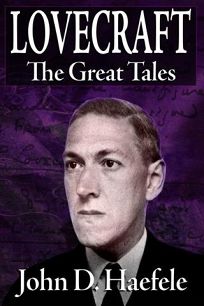 Lovecraft: The Great Tales/ John D. Haefele (Cimmerian Press, 2021): John D. Haefele’s The Derleth Mythos was a book that made me do if not a 180, a 135 degree turn on my view of August Derleth.
Lovecraft: The Great Tales/ John D. Haefele (Cimmerian Press, 2021): John D. Haefele’s The Derleth Mythos was a book that made me do if not a 180, a 135 degree turn on my view of August Derleth.
The Great Tales has 746 pages of text. John Haefele goes through Lovecraft’s evolution as a writer. Each chapter generally discusses influences as Lovecraft would discover another writer. Poe, Lord Dunsany, Arthur Machen, Algernon Blackwood, Robert W. Chambers, William Hope Hodgson are given prominence. I did not realize that Lovecraft discovered Chambers and especially Hodgson so late. Space is given to his circle: Frank Belknap Long, Clark Ashton Smith, Donald Wandrei, Robert E. Howard, Robert Bloch with mention of Moore, Kuttner, and Leiber.
Robert E. Howard is brought in on the chapter entitled “Innsmouth.” Haefele gives Howard credit that he was no push-over when debating Lovecraft. He also agrees with my view that too much time and effort were given to the barbarism-civilization debate and that it ultimately soured the relationship. Howard had put some distance with Lovecraft by 1935.
This book is a deep dive into Lovecraft. It is not for a neophyte new to Lovecraft. Once someone has read Lovecraft, the influences, and sampled fiction from his circle of friends/correspondants, the they can then undertake this book. This is not a book that you will polish off in a few days. It took a few weeks to get through it as I wanted to digest John Haefele’s ideas and points.
The Great Tales is a counter to some of the ideas that Sunand Tryambak Joshi has pushed in his Lovecraft biographies. Joshi attempted to separate Lovecraft from the pulps and the pulp fiction writers that made up his circle. Joshi has the angle of making H. P. Lovecraft an important philosopher of the 20th Century. Haefele restores Lovecraft to the pulps. Lovecraft read tons of pulps in his younger years and kept up with Weird Tales despite his opinion of much of the contents. I have discussed Weird Tales editor Farnworth Wright with John and he is on the same page with me. Did Lovecraft think of markets outside of the American pulp magazines? There were some British horror anthologies in the 1930s, the Creeps series come to mind. It looks like Lovecraft was unaware of them or did not submit stories.
Themes recurrent with Lovecraft are dreams and the earth as a force, often evil. I wrote to John on the “Earth-Mother” idea. He got back to me:
“Throughout the canon HPL intimates that all entity has a degree of sentience, a Blackwood-Willow-like consciousness, a literalism beyond a stylistic application of anthropomorphism. As examples, think of the avenue in ‘The Street,’ the dilapidated buildings in Innsmouth, the baleful influence of appropriately named stars & planets, & so on. We understand that the common attribute of organic & inorganic entity is Memory, but we also perceive Will and Purpose.
In the physical world, the Earth itself, one of the greater elemental powers, draws to its center (a Lovecraftian form of gravity?) individual beings and entire races. There we find HPL’s related concept, or conceit, a vast underground gulf–an infernal world under the sway of this Mother Earth–where residual elder powers still exist. The analogous concepts in the dreamscape may be Nodens and the Great Abyss.”
Lovecraft is one of the writers that I do reread when in the mood. Lovecraft is a huge influence on the genesis of sword & sorcery fiction. Robert E. Howard and Clark Ashton Smith are the Jachin and Boaz of the genre, but Lovecraft serves in background as a third pillar.
Example:
“Of the Shining Trapezohedron he speaks often, calling it a window on all time and space, and tracing its history from the days it was fashioned on dark Yuggoth, before ever the Old Ones brought it to earth. It was treasured and placed in its curious box by the crinoid things of Antarctica, salvaged from their ruins by the serpent-men of Valusia, and peered at aeons later in Lemuria by the first human beings. It crossed strange lands and stranger seas, and sank with Atlantis before a Minoan fisher meshed it in his net and sold it to swarthy merchants from nighted Khem. The Pharaoh Nephren-Ka built around it a temple with a windowless crypt, and did that which caused his name to be stricken from all monuments and records.” – “The Haunter of the Dark.”
Lovecraft used elements from Clark Ashton Smith and Robert E. Howard but also gave inspiration. You see the Shadow of Lovecraft when you read Henry Kuttner’s “Elak of Atlantis,” C. L. Moore’s “Black God’s Kiss,” Gardner F. Fox’s “Heart of Light,” and so on and so forth. Weird fiction got heavier. There is a reason he is in Appendix N. You can order Lovecraft: The Great Tales in trade paperback form.
Please give us your valuable comment